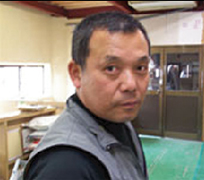Storage Expert
Stainless Steel + Aluminum Putty Palettes
Measuring Ladle
The Craftsman's Finish




Before applying a thin finish to the wall surface, please properly treat the wall foundation. If the foundation treatment is poor, cracks and flaws may occur. Please read the foundation treatment materials and instructions thoroughly.
Spread the material (such as diatomite, plaster, or juraku) on the wall. Here, try to apply it with a consistent thickness, and be careful to avoid any unevenness. Also, the proper thickness depends upon the material used, so please read all instruction materials thoroughly.
| Diatomite | Natural material made from the silicate shell of fossilized plankton. Known historically to be fire resistant. |
|---|---|
| Lime Plaster | Made with slaked lime and a filler, such as paper or linen, mixed with glue. Has a long history of use. |
| Juraku | Sourced only from Kyoto, this is traditionally used as a great fire resistant material. |

Together with Samejima Corporation, a pioneer of diatomite plaster production and sales in Japan, the genuine intention is to create a plaster from natural materials. Haruguchi uses the mastery of his craft and knowhow cultivated over a long career, with a monthly average application of over 5,000㎡*.
Leveraging this abundant experience, he became the idea man for easy-to-use tools for actual job sites and situations. From the universal to the specific craftsman, he shares his knowledge freely and extensively. Lovingly referred to as "Haru-san/Mr. Haru" by those close to him, being pulled one way or another from clients and fellow plaster craftsmen has made him a popular, busy artisan.
* 5,000㎡ (1㎡=1,000mmX1,000mm) This is an approximation, based upon a single detached house averaging around 300㎡ – 400㎡ of walls and ceilings. 5,000² ÷ 400² = 12.5 (homes) ~ 5,000² ÷ 300² = 16.6 (homes) Apartments and condominiums have an average of 200㎡ – 300㎡ of walls and celings 5,000² ÷ 300² = 16.6 (homes) ~ 5,000² ÷ 200² = 25 (homes)